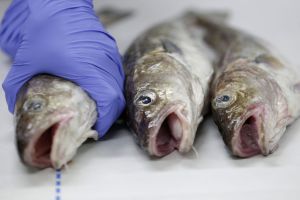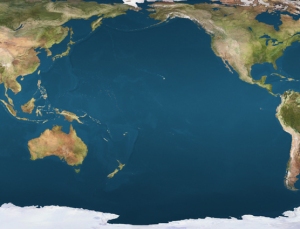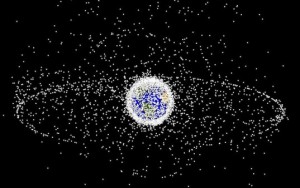Seaborne radiation from Japan’s wrecked Fukushima nuclear plant will wash up on the West Coast of the U.S. this year.
That’s raising concerns among some Americans including the residents of the San Francisco Bay Area city of Fairfax, which passed a resolution on Dec. 6 calling for more testing of coastal seafood.

At the same time, oceanographers and radio-logical scientists say such concerns are unwarranted given existing levels of radiation in the ocean.
The runoff from the Japanese plant will mingle with radiation released by other atomic stations, such as Diablo Canyon in California. Under normal operations, Diablo Canyon discharges more radiation into the sea, albeit of a less dangerous isotope, than the Fukushima station, which suffered the worst nuclear accident since Chernobyl.
“There’s a point to be made that we live in a radioactive world and the ocean just has radioactive isotopes in it,” said Ken Buesseler, senior scientist at the Woods Hole Oceanographic Institution inMassachusetts, who forecasts the Fukushima plume will arrive in the U.S. early this year. “People have a limited knowledge of radioactivity.”
Leaking Groundwater
At Tokyo Electric Power Co. (9501)’s Fukushima Dai-Ichi station, where three reactors melted down after the March 2011 earthquake and tsunami, about 300 metric tons of contaminated groundwater seep into the ocean each day, according to Japan’s government.
according to Japan’s government.
Between May 2011 and August 2013, as many as 20 trillion becquerels of cesium-137, 10 trillion becquerels of strontium-90 and 40 trillion becquerels of tritium entered the ocean via groundwater, according to Tokyo Electric.
Cesium isotopes, which emit flesh-penetrating gamma rays, are among the most dangerous radionuclides emitted by the plant, said Colin Hill, an associate professor of radiation oncology at the University of Southern California’s Keck School of Medicine.
Strontium-90, which mimics calcium, increases the exposure risk for humans by remaining in the bones of fish for extended periods. While tritium is less radiologically intense than cesium and passes through fish faster than strontium, it can also contaminate sea creatures that encounter the isotope in high levels, Hill said.
Not Happy
Water exposed to radiation from the Fukushima plant would reach the U.S. at levels at least 100 times lower than the U.S.’s drinking water threshold, Nuclear Regulatory Commission chairman Allison Macfarlane said at a Dec. 6 briefing in Tokyo.

The assurances haven’t eased concerns for some. “I’m terrified,” Doreen Jean Dempski, a children’s book author, said by phone from her home more than 5,000 miles across the Pacific from Fukushima in Carpinteria, California. “My boyfriend is a surfer and he spends hours a day in the water.”
Sharing Dempski’s worries are the Fairfax city council, which passed the coastal testingresolution, and more than 127,000 signatories to an online petition calling for a United Nations’
takeover of part of the Fukushima cleanup. South Korea has already banned imports of fish from Japan’s northern Pacific coast.
Fukushima radiation is being erroneously blamed for everything from sea-lion deaths to sickened polar bears, according to an editorial this week in Canada’s Times Colonist newspaper.
Risk Expectations
Part of the issue is general concern about radiation, and the startling amounts that are released into the environment by the 435 nuclear power plants operating worldwide as of Jan. 3. Measurements that puzzle the public — becquerels, rems, curies and sieverts — don’t aid transparency. And, worse, scientists disagree on the health risks from low-dose radiation exposure.
A report on the Fukushima disaster by the World Health Organization in February last year estimated increased cancer risk for those in the most contaminated areas around the plant, but not elsewhere in Japan. However, the report also notes that better understanding of the effects of low-dose radiation may alter risk expectations from the Fukushima accident.
Less than 100 miles up the coast from Dempski’s home, Pacific Gas & Electric Co.’s Diablo Canyon plant in San Luis Obispo discharged 323 million liters of water into the Pacific in 2012, or about 870 tons a day, according to data from the company on the U.S. Nuclear Regulatory Commission’s website. That’s equivalent to 130 Olympic swimming pools and more than twice the daily amount leaking from Fukushima.
Inadvertent Contact
That water contained 3,670 curies of tritium, or 136 trillion becquerels, according to the company, almost three-and-a-half times the amount released from the Fukushima plant into the ocean in the period starting May 2011. The plant also discharged cesium-137, though at lower levels than Fukushima, while its output of strontium-90 is below detectable levels.
Diablo Canyon’s discharges are regulated by the NRC and the plant complies with its licensing requirements, PG&E spokesman Blair Jones said in an e-mail. Total liquid discharges from Diablo Canyon in 2012 were 0.0165 percent of what the NRC allows, Jones said.
The radioactivity in plant wastewater comes from inadvertent contact between the isotopes and cooling water pumped through nuclear plants.
“Tritium is produced when a reactor is operating,” Jones said. “Fukushima is not operating so naturally the tritium levels are lower when compared to Diablo Canyon.”
Rick Castello, a San Luis Obispo-based project manager for a technology company, said by phone that he was unaware of the discharges from the nearby nuclear plant. He also harbors concerns about the approaching radiation from Fukushima.
“It’s not like I think official sources would be intentionally hiding information from the people,” he said by phone. “But sometimes we just don’t know.”
Another great Green article from Green Halo
Track your recycling at www.greenhalosystems.com
Follow Green Halo on Twitter at http://twitter.com/greenhalousa
 Even though Japan has already said it will cancel next season’s Antarctic expedition in light of the ruling, there are still two other expeditions, one along the country’s northern coast, and another in the northern Pacific, that could both continue as planned within the next few weeks. The average kill count for those programs is often around 300 minke whales each year.
Even though Japan has already said it will cancel next season’s Antarctic expedition in light of the ruling, there are still two other expeditions, one along the country’s northern coast, and another in the northern Pacific, that could both continue as planned within the next few weeks. The average kill count for those programs is often around 300 minke whales each year.







